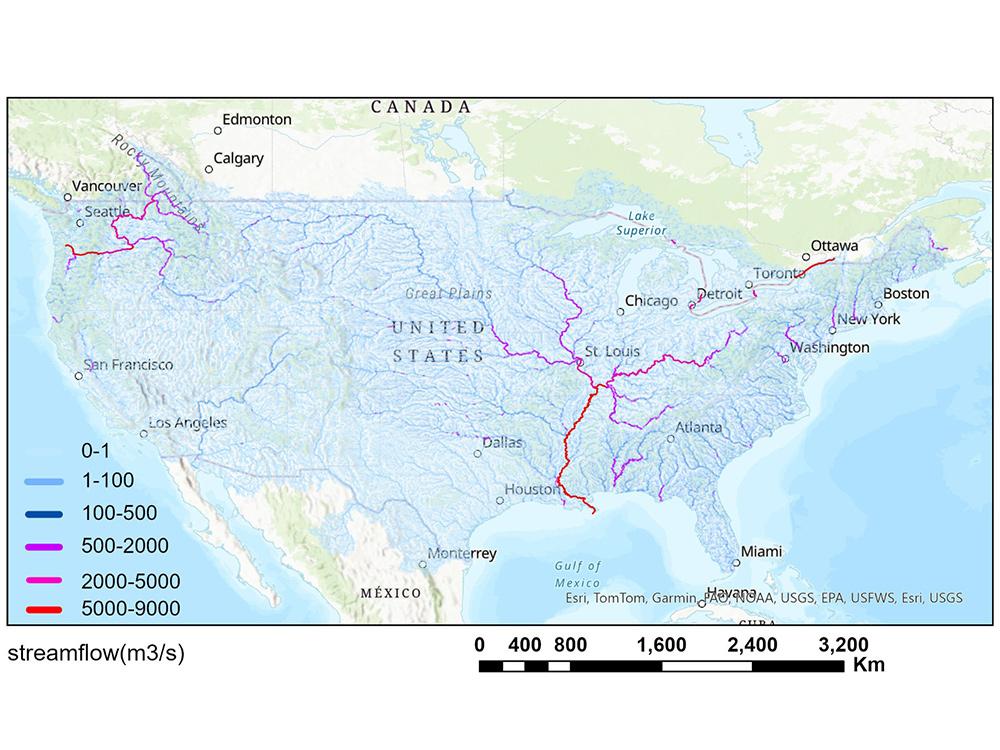2025-07-02 ペンシルベニア州立大学(PennState)
 By implementing AI, the team’s water model is able to produce highly accurate streamflow predictions, like the one shown above. The fastest moving river systems appear red, with its speed measured in cubic meters. Credit: Provided by Yalan Song. All Rights Reserved.
By implementing AI, the team’s water model is able to produce highly accurate streamflow predictions, like the one shown above. The fastest moving river systems appear red, with its speed measured in cubic meters. Credit: Provided by Yalan Song. All Rights Reserved.
<関連情報>
- https://www.psu.edu/news/engineering/story/improving-predictions-flood-severity-place-and-time-ai
- https://agupubs.onlinelibrary.wiley.com/doi/10.1029/2024WR038928
マルチスケール微分物理学に基づく機械学習により、国家規模の高解像度水モデリングが強化される High-Resolution National-Scale Water Modeling Is Enhanced by Multiscale Differentiable Physics-Informed Machine Learning
Yalan Song, Tadd Bindas, Chaopeng Shen, Haoyu Ji, Wouter J. M. Knoben, Leo Lonzarich, Martyn P. Clark, Jiangtao Liu, Katie van Werkhoven, Sam Lamont, Matthew Denno …
Water Resources Research Published: 10 April 2025
DOI:https://doi.org/10.1029/2024WR038928
Abstract
The National Water Model (NWM) is a key tool for flood forecasting, planning, and water management. Key challenges facing the NWM include calibration and parameter regionalization when confronted with big data. We present two novel versions of high-resolution (∼37 km2) differentiable models (a type of hybrid model): one with implicit, unit-hydrograph-style routing and another with explicit Muskingum-Cunge routing in the river network. The former predicts streamflow at basin outlets whereas the latter presents a discretized product that seamlessly covers rivers in the conterminous United States (CONUS). Both versions use neural networks to provide a multiscale parameterization and process-based equations to provide a structural backbone, which were trained simultaneously (“end-to-end”) on 2,807 basins across the CONUS and evaluated on 4,997 basins. Both versions show great potential to elevate future NWM performance for extensively calibrated as well as ungauged sites: the median daily Nash-Sutcliffe efficiency of all 4,997 basins is improved to around 0.68 from 0.48 of NWM3.0. As they resolve spatial heterogeneity, both versions greatly improved simulations in the western CONUS and also in the Prairie Pothole Region, a long-standing modeling challenge. The Muskingum-Cunge version further improved performance for basins >10,000 km2. Overall, our results show how neural-network-based parameterizations can improve NWM performance for providing operational flood predictions while maintaining interpretability and multivariate outputs. The modeling system supports the Basic Model Interface (BMI), which allows seamless integration with the next-generation NWM. We also provide a CONUS-scale hydrologic data set for further evaluation and use.
Key Points
- High-resolution differentiable models offer substantial and widespread improvements for CONUS streamflow prediction accuracy
- With a differentiable routing model, we produced a seamlessly discretized streamflow product across approximately 180,000 CONUS river reaches
- Multiscale training can resolve spatial heterogeneity and improve peak flow, while explicit routing enables large-river simulations



